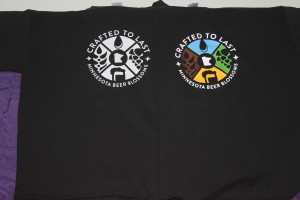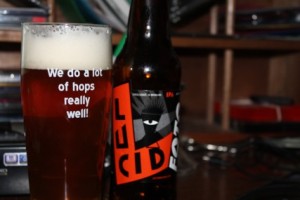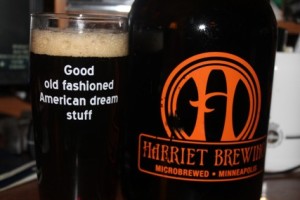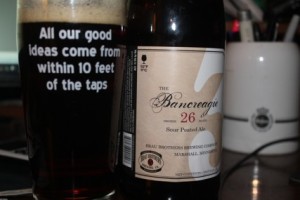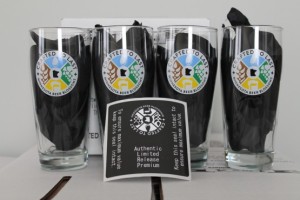News
now browsing by category
Upcoming events and news
The film gets a score
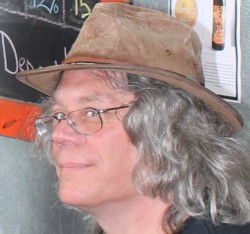 I’m always pleasantly surprised when I watch Crafted to Last – Minnesota Beer Blossoms and once again realize how closely it resembles the film I pictured in my head while making it. The main lesson I learned was that many more voices could be included in the film. My original target was 8-10 people in the film because I thought that too many voices might be confusing. To my great delight I soon began to understand that when many voices speak intelligently and with passion about the same subject, more is definitely better. Thirty-six people appear in the documentary and I think we could have squeezed in a few more. The idea was to create a narrative track that is basically one long conversation between all the people appearing in the film. Recording the speakers in pairs set the stage for this because it brings the viewer into the conversation as they listen with the silent on-screen partner.
I’m always pleasantly surprised when I watch Crafted to Last – Minnesota Beer Blossoms and once again realize how closely it resembles the film I pictured in my head while making it. The main lesson I learned was that many more voices could be included in the film. My original target was 8-10 people in the film because I thought that too many voices might be confusing. To my great delight I soon began to understand that when many voices speak intelligently and with passion about the same subject, more is definitely better. Thirty-six people appear in the documentary and I think we could have squeezed in a few more. The idea was to create a narrative track that is basically one long conversation between all the people appearing in the film. Recording the speakers in pairs set the stage for this because it brings the viewer into the conversation as they listen with the silent on-screen partner.
I had planned from the outset to break up the conversation with some sort of digression or a musical interlude, but the final context and content of what would become the Water and Beer Interludes was far from certain. There were a lot of ideas along the way. Animations, customer comments, history lessons, all were pursued to one extent or another. Both interludes were ways to include material that would have otherwise been deleted from the film. The discussions of water and descriptions of beers were too long and had not found a stable place in the time line. I had already made the dialogue track for the Water Interlude before Zack Lozier ever saw the film. He wrote and recorded “Here Come the Water” in the first round. The success of the Water Interlude in saving that dialogue from the edit suite floor encouraged me to revisit the brewers describing their beers. The result was the experimental Beer Interlude where we play around with sound and image.
I had worked with Zack’s music before I ever met him. Jesse Brödd sent me an MP3 of Fallout by one of his bands, Big Blue Station Wagon, to use in a short video I made for the 1 year anniversary of the Harriet Brewing Tap Room. The result – Three Minute Tap Room – compresses the build out of the tap room over roughly 3-4 months into approximately 3 minutes. The Tap Room Time Progression video is a critical element of the film. It is a visual rendition of what happened in MN when the tap room/pint/Surly Bill became the law of the land. Fragments of it show up multiple times in Crafted to Last and there is even a sense of the full progress of time when Jason and Jesse tell us about the controlled chaos of the build out, but nothing captures the dynamism and kinetics like Three Minute Tap Room. The music of Big Blue Station Wagon had pushed me in the right direction.
The plan was to make a documentary without a narrator or an interviewer. This puts more weight on the sound track, specifically the score to delineate parts of the movie and set the emotional context. Working with a local musician to compose an original score was in tune with a theme of local community that resonates throughout the narratives of the people in the film. After a few dead ends, I finally talked to Zack Lozier and he agreed to meet at Town Hall Lanes.
We talked about music, moods and what I wanted to accomplish with the score. I explained my perspective that film is composed of 3 tracks. Dialogue, Sound and Image. I would sculpt the Dialogue track from all the people narrating the film and assemble the Image track from A, B and C Roll video. Zack would create the film score; the main element of the sound track. He was intrigued by the project because it challenged him to compose a lot of new music and to collaborate with a film maker. Something he wanted to do and something he had never done before. He agreed to experiment first and ask questions later, so the deal was done.
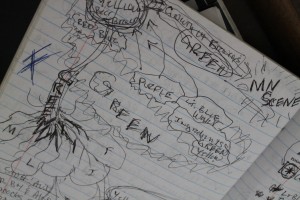 I gave Zack a very early rendition of the film so that he could get a sense of what we had and where it was going. He is one of a very select cohort lucky enough to have seen Crafted to Last in its entirety without the B Roll video. Even so, he was able to discern the general themes in the film and begin making music to enhance the story. To give him a visual image that summarized the gist of the film I explained the scribbled diagram pictured to the left because it depicts the basic structure of the film. It shows a dessicated seed bursting out when suffuse with sparkling water that grows into a healthy plant well rooted in the local nurturing soil and then blossoming forth into full, succulent blooms. Each of the home brewers that went on to be featured in Crafted to Last are like the seeds, their breweries are the plants, and everything that comes from them are the blossoms. Reform of the distribution laws was like rain watering the seeds and stimulating them to grow in the rich soil of the local neighborhood.
I gave Zack a very early rendition of the film so that he could get a sense of what we had and where it was going. He is one of a very select cohort lucky enough to have seen Crafted to Last in its entirety without the B Roll video. Even so, he was able to discern the general themes in the film and begin making music to enhance the story. To give him a visual image that summarized the gist of the film I explained the scribbled diagram pictured to the left because it depicts the basic structure of the film. It shows a dessicated seed bursting out when suffuse with sparkling water that grows into a healthy plant well rooted in the local nurturing soil and then blossoming forth into full, succulent blooms. Each of the home brewers that went on to be featured in Crafted to Last are like the seeds, their breweries are the plants, and everything that comes from them are the blossoms. Reform of the distribution laws was like rain watering the seeds and stimulating them to grow in the rich soil of the local neighborhood.
Amazingly, that was enough to inspire Zack to make an entire film score of new music with a cohort of players culled from around the Twin Cities. A couple more rounds of feedback and adding instruments to the mix and we had the music for the film. Working with Zack was a pleasure and it notably enhanced the film. That success encouraged us to take on the more experimental parts of the film. Where the Water interlude minimally digresses from the film to bring in lyrics from the score, the Beer interlude goes further as we mix dialogue and image with a more restrained score that echoes fermentation in the beat. These brief interludes distinguish Crafted to Last from other films about craft brewing and they came about organically while collaborating with Zack to create the score. These are my favorite parts of the film for these and many other reasons. Enjoy.
The Stuff Raffle
We have movie-related stuff. You can buy it at the screening events or contact us to purchase stuff. There will be a Stuff Raffle, too. At each of the screenings we will offer 4 prizes in the Stuff Raffle.
1) Crafted to Last T-shirt in B/W or Full Color on black 100% cotton.
2) DVD copy of the film. Handmade DVD package with 8 page insert.
3) Series #1 Glasses. Set of 4 Willi Becher pint glasses featuring a full color logo and quotes from the film. Boxed, numbered, authenticated and sealed for maximum value. Limited edition; 125 numbered sets.
4) Series #2 Glasses. Set of 4 Willi Becher pint glasses featuring B/W logos. Boxed, numbered, authenticated and sealed for maximum value. Limited edition; 125 numbered sets.
These are the Series #1 glasses pictured with beers from the brewery of the person quoted on each glass. Jon Messier, Ted Marti, Jason Sowards and Dustin Brau. The other side of the glasses feature a full color CTL logo on a white background.
Series #2 glass sets feature 4 distinct designs with black and white CTL logos on round or square backgrounds. One of these shows up in the documentary, over flowing with Hot Box Imperial Smoked Pepper Porter a collaboration beer from Indeed and Northbound Smokehouse.
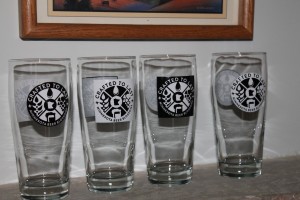
 All 4 prizes will be given away in the Stuff Raffle at every screening event during the CTL Film Tour 2015. Tickets will be available at the events.
All 4 prizes will be given away in the Stuff Raffle at every screening event during the CTL Film Tour 2015. Tickets will be available at the events.
You can buy this stuff, too. We’ll have stuff for sale at the screenings. Or you can contact me to order what ever pieces of film related stuff you might desire.
The Stuff Raffle is pretty simple. People get tickets and tear them in half so that each stub has matching numbers. They keep one half and put the other into the container that corresponds to one of the 4 prizes. When the movie ends, we’ll pick 4 winners from the stubs in each of the 4 boxes. You must be present and show the corresponding stub to collect a prize. Tickets will be widely available at low and no cost during the screening events. I mean, we’ll be giving tickets away and selling them for $2.
One way to score free Stuff Raffle tickets is to brush up on Crafted to Last – Minnesota Beer Blossoms trivia. This article is a goldmine of information that could very easily lead to free Stuff Raffle tickets and with some luck, Free Stuff. The best source is the MN Craft Beer Project Channel, where Crafted to Last and CDDF Productions routinely release new and vintage content. Matching people to quotes from the film, whether documented on glassware or not, seems a fertile place to for trivial knowledge.
So too, this video “Right Before it Began“. Careful listeners will find 4 clues to the design of Series #1 glass sets for Crafted to Last – Minnesota Beer Blossoms. This is the kind of knowledge that will get you Free Stuff. Seriously.
Crafted to Last Film Tour 2015
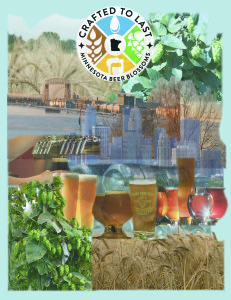 Schedule for May and June 2015:
Schedule for May and June 2015:
May 2 – Lucid Brewing Company – Minnetonka -TBA
May 14 – Lift Bridge Brewing Company – Stillwater –
6:30 PM
May 15 – Kinney Creek Brewing Company – Rochester –
6:00 PM
May 16 – Northgate Brewing Company (Art A Whirl weekend) – Minneapolis – 1:00 PM
June 3 – Day Block Brewing (Pilot Batch Wednesday) – Minneapolis – 6:00 PM
June 20 – Bent Paddle Brewing Company – Duluth – 6:30 PM
June 29 – West Medicine Lake Community Club – Plymouth – TBA
There is no charge, but some venues may require tickets. Show times subject to change. Check with the venues for up-to-date information and requirements. Film runs 85 minutes. Door prizes. Merchandise. Local beer. Home brewed film.
Even at this early stage, the CTL Film Tour mirrors the state-wide geographic scope of the documentary itself. It is also pretty cool that screenings will coincide with the BFD Award Ceremony at Lucid (May 2), Art-A-Whirl at Northgate (May 16) and Pilot Batch Wednesday at Day Block (June 3). All of these events reinforce themes from the film. Home brewing, experimental brewing, community engagement and connection to other artists are critical threads running through the story of Minnesota brewers as told in the documentary.
There are still a few dates available in June and plenty more this Summer and Fall. Contact us at [email protected] if you’d like to arrange a screening. I especially encourage those so inclined to think about working with me to create an event – or even some beer(s) – around the film and the showing. I’m willing to show the film in pretty much any venue one can imagine and it would do my old heart a lot of good if someone were to suggest a venue I’ve not yet imagined. Seriously. Get in touch.
 Rumors that Paul Johnston and Dan Banks are cooking up something extra special for the Day Block Pilot Batch Wednesday on June 3 have been confirmed by a source that most likely knows something is in the works. I’ve challenged them to come up with a set of Pilot Batch beers that are as Minnesotan as possible – whatever that might mean. I can’t wait to find out what they got brewing.
Rumors that Paul Johnston and Dan Banks are cooking up something extra special for the Day Block Pilot Batch Wednesday on June 3 have been confirmed by a source that most likely knows something is in the works. I’ve challenged them to come up with a set of Pilot Batch beers that are as Minnesotan as possible – whatever that might mean. I can’t wait to find out what they got brewing.
It is satisfying to finally work with Paul on a project that will come to fruition. I had to cut Paul out of Crafted to Last. This time things will be different. Don’t miss it.
Public Testimony in Support of Sunday Liquor Sales
The Minnesota House Commerce and Regulatory Reform Committee met for an informational session on the issue of repealing the ban on liquor off-sales on Sunday. A number of people testified in support of the bill introduced by Rep. Jenifer Loon (R; 48B).
The statements were recorded and cut away video downloaded from the MN House feed. Statements have been slightly edited for content. Click links for video. Testimonies in order of appearance:
Troy Wing – La Crescent Wine & Spirits.
Louis Dachis – Ace Spirits
Jason Alvey – The Four Firkins Beer Stores
Katrina Karter – Small Business Owner
Kristi Szewczk – Parent and Sunday Shopper
Walter Hudson – Albertville City Council
Andrew Schmitt – Minnesota Beer Activists & MN Sunday Sales
Dave Erickson – D’Erick’s Tower Liquor
Ryan Freeman – Minnesotan
Feel free to use these video clips in whatever way you see fit to support Sunday sales in Minnesota liquor stores. Find embed codes at the links or at MN Beer News.
Hoppe for Reform of Sunday Sales?
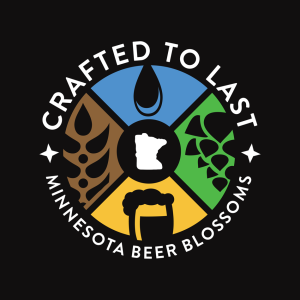 In mid-afternoon on April 8, 2015 in Room 10 of the Minnesota State Office Building, Rep. Joe Hoppe (R; 47B) called the House Commerce and Regulatory Reform Committee to order and quickly turned to Rep. Jenifer Loon (R; 48B) to concisely review the two bills she has offered to the legislature. The video clip includes an exchange between Loon and Rep. Raymond Dehn (DFL; 59B) that she deftly plays to good effect. Dehn’s logically-challenged and vaguely emotional broadside of store owners was reminiscent of satirical parody. Especially in light of the preceding testimony from a number of business owners of precisely the type Dehn called out. By my count, 10 people testified in support of the Loon Bills. At least 4 of these were retailers and 2 represent consortia of retailers and manufacturers.
In mid-afternoon on April 8, 2015 in Room 10 of the Minnesota State Office Building, Rep. Joe Hoppe (R; 47B) called the House Commerce and Regulatory Reform Committee to order and quickly turned to Rep. Jenifer Loon (R; 48B) to concisely review the two bills she has offered to the legislature. The video clip includes an exchange between Loon and Rep. Raymond Dehn (DFL; 59B) that she deftly plays to good effect. Dehn’s logically-challenged and vaguely emotional broadside of store owners was reminiscent of satirical parody. Especially in light of the preceding testimony from a number of business owners of precisely the type Dehn called out. By my count, 10 people testified in support of the Loon Bills. At least 4 of these were retailers and 2 represent consortia of retailers and manufacturers.
Rep. Dehn’s puzzlement as to the motivation of small business owners and right-minded legislators with regard to repeal of Sunday sales prohibition was quelled by the Q&A with Rep. Sarah Anderson (R; 49A) that got right to the nub of the biscuit when she asked the assembled retailers to estimate how much business they lose every Sunday.
When Dave Erickson, D’Erick’s Tower Liquor, testifies that at least a dozen and at most 50 people seeking off-sale liquor are turned away from his store on any given Sunday, I think about all the dollars hitch-hiking to neighboring states with thirsty Minnesotans every weekend. It strikes me that Dave’s story is the mirror image of that cross-border parade because he is talking about disappointing tourists from other states when they try to buy a few MN beers on their way out of town after having the time of their lives exploring Tower and Lake Vermillion. It is important because when retailers that depend on tourism fail to capture those outside dollars the entire region loses that particular piece of pie. If people stay home, or choose to visit a more reasonable destination, because they do not want to be caught up in the backward archaic Blue Laws in Minnesota, its a few more money dollars lost.
Jason Alvey, The Four Firkins Beer Stores, suggests that economic benefit to the tune of $3000-5000 per week might be realized by closing on Monday and opening on Sunday. Monday is traditionally the least active day of the week for liquor stores, while Sunday may well be one of the best days for retail sales. This argument undercuts the contention that opening on Sunday will prove a losing proposition for some retailers. At a minimum, Alvey’s analysis suggest that without changing the number of days open in a week, stores could realize more sales by closing on a slow day and opening on Sunday.
When I hear Jason Alvey talking about losing significant revenue every Sunday that he is prevented from opening his doors at The Four Firkins, I think about all the local businesses his stores support with the dollars you and I spent there last week. I mean, small businesses turn it over just that quick. When you spend locally, a piece of your money cycles back and does for a positive economy what vaccination is said to do for the the proverbial herd. It makes our economic community more robust from the grass roots up.
Rep. Anderson lobbed the next soft ball right into David Ozgo’s sweet spot and he got extra bases with his estimate of $11 -15 million of increased tax revenues if Sunday sales are allowed. Taken in context of the testimony of Alvey and Erickson, among others, that point to beneficial increases in local cash flow through the private sector, the increased tax revenues indicate a parallel enhancement in the public sector funds. I see the increased tax revenue from Sunday sales as a kind of silent tax increase. The state gets more revenue, but no one feels particularly beset by the tax collector. Instead, we’ll be rejoicing that we can buy packaged booze and beer on Sunday while happily spilling cash into our chosen Sin Tax bucket as we sample another session beer and take notes for the upcoming bottle share. Even if all your faith system will allow you to think should be done with a budget surplus such as we have is to write your own version of a Jesse Check or a GWB Check you must agree that more surplus is better than less surplus because, if nothing else, bigger checks mean more votes and sloppier slush funds for attack ads.
The two preceding video clips highlight the main economic arguments for the repeal of Sunday sales prohibition. They suggest that the change will benefit the private and public sectors through increased sales and tax revenues respectively. It is not all the time that public and private economic interests align and in this case the will of the people resonates with reform as well. The impact of the hearing depicted in these clips has been to solidify a base of support for Sunday sales reform. Instrumental to the recent success have been Reps. Jenifer Loon and Sarah Anderson, who with the guidance of Chair Joe Hoppe have set the table for the MN Republicans to make reform of liquor distribution laws a central issue for their caucus moving forward.
The last word here belongs to Rep. Loon. In response to Rep. Dehn she undercuts his argument that liquor retailers should not petition to change distribution laws because these are time-tested and effective. Of course, the testimony of the supporters of repealing Sunday sales prohibition strongly undercuts the cynicism of Rep. Dehn and should offer him a way out of the politically untenable morass into which he and the DFL have stumbled.
CTL Film Tour 2015 – March Update
Lift Bridge Brewery on May 14
Kinney Creek on May 15
Northgate on May 16 during Art-A-Whirl
Day Block on June 3 during Pilot Batch Wednesday
June 29 at West Medicine Lake Community Club
Showtimes vary, check with venues
A couple of days ago a fan contacted me about hosting a screening in his home. We chatted about the idea over beer. We’ll show the film to a select group friends while sharing beers and talking about Minnesota beer. I like it.
Would you like to host a screening during the CTL Film Tour 2015? Dates still available, June through November. Contact us.
Crafted to Last merchandise will be available at the screenings. T shirts, glasses and DVDs. Black 100% cotton shirts feature either white or full color film logo. Glasses are Willi Becher style pints. Available in 4 B/W designs and 4 full color designs with quotes from the film. Both are available as limited edition boxed sets of 4 distinct glasses, numbered, sealed and authenticated. Only B/W glasses will be sold individually.
This video is from a past crowd funding campaign, but it nicely summarizes what you need to know about limited edition glass sets.
This Time in History
 Timing is everything and good location a plus. When I first met Jesse Brödd and Jason Sowards to talk about video and beer, they were just about to implement their plans for a tap room in the back of the garage at Harriet Brewing Company. Back then, I was working at the VA, down by Minnehaha Falls and the airport. The brewery was close by and I could easily stop by once a week, on my way home or during lunch, to shoot video of the build out of the new tap room.
Timing is everything and good location a plus. When I first met Jesse Brödd and Jason Sowards to talk about video and beer, they were just about to implement their plans for a tap room in the back of the garage at Harriet Brewing Company. Back then, I was working at the VA, down by Minnehaha Falls and the airport. The brewery was close by and I could easily stop by once a week, on my way home or during lunch, to shoot video of the build out of the new tap room.
Harriet was the first to sign on to the project. It was an auspicious start because immediately I had a chance to capture video of a brewery adding a tap room. The tap room time progression sequence was a critical visual counterpart to the narratives about tap rooms and the reform that made them legal in January 2012. That it became possible during the first meeting with brewers interested in joining the documentary was serendipitous timing. It set the pace and planted the seed.
Later that Spring, talking with Rob Miller and Sarah Bon Vallet it became clear that we had an opportunity to make a time progression sequence of the installation of the entire brewery at Dangerous Man. I thought back to my discussions with Joe Pond from Olvalde Farm. Particularly the distinctions he draws between his agricultural approach and the industrial models followed by most other breweries. I wanted to balance the focus on growth in the beer industry with the agricultural aspects of the ingredients. The barley field time progression sequence shot from late Spring until early Fall 2012 at Olvalde Farm was the visual complement to the urban/industrial sequences of tap room and brewery growth at Harriet and DMBC. It would not have been possible without Carlus Dingfelder, Joe’s father in law. Video of hops would come later. At Hippity Hops Farm with Matt Hall from Lift Bridge.
Everything is about time in Crafted to Last. The narratives, the images, the music. Place is important, but it kind of took care of itself. The documentary is about Minnesota because it was made here, many of the people in the film were born here, and some have deep family roots in the state. The film is about a specific time in Minnesota beer brewing history and the industry was expanding very quickly at that time. The 3 time progression sequences and many time lapse segments were used to visually evoke the fast moving MN beer scene while the movie was being made. We shot time lapse at these locations: The Brew Day Time Lapse with Greg Smith at Leech Lake, Rob Miller at Dangerous Man, Waxing Old Friend at Indeed, various Art Hangings and Tap Room Opening at Harriet, and tank delivery at Northbound.
Because beer is so closely tied to human history and nostalgia, it was important to couch the current era in historical context. Prohibition, consolidation, the craft beer movement, regulatory reform, and a renewed interest in local businesses all of these contributed to the cultural and economic context in which Minnesota beer began to blossom in 2012.
When Ted Marti from August Schell’s Brewery agreed to participate, we welcomed his unparalleled historical perspective. The narratives of the Hoops brothers with their cohorts Tim Nelson (Fitger’s Brewhouse) and Pete Rifakes (Town Hall Brewery), provided a more recent focus on locally brewed beer, brew pubs and growing a community of craft beer drinkers in Duluth, MN. Personal and neighborhood histories intersect for Bob Nihart (Reads Landing Brewing Co.), the brew pub, and the town of Reads Landing. These were the historical context in which the film portrays the expansion of the brewing sector from January 2012 forward.
The drawing above is one of the first renditions of the complete film in any tangible medium. The written out colors refer to the code for identifying clip content in the editing software. It shows a twisted flower blooming from a seed that has been nurtured by laws, culture, water, dollars and effort. The bloom is upside down in the lower left corner and the seed in the upper left. To the right are those things that feed the transformation of the seed into the flower. In the film there are many different seeds and at least as many blooms. The seed of home brewing for each featured brewer and the flush of new breweries, for example. The sub-title of the film came out of this drawing. Minnesota beer blossoms.
The video diary clip celebrates one of the first milestones in making the film. I had shot conversations at the first 4 breweries and was planning shoots at 4 more. At the time I recorded this commentary, 8 breweries was the upper bound for the film because I was still planning to include people from other businesses that had been positively impacted by the expansion of brewing. On camera I’m talking about the transformation of my beer cellar from foreign to Minnesotan. Off camera I’m drawing pictures of seeds transforming into flowers using elements coded for types of video content. On location we were capturing that time in Minnesota brewing.
Right now you can watch my home brewed film and drink Minnesota beer at a location near or far during the CTL Film Tour 2015.
Spent Video & Compost
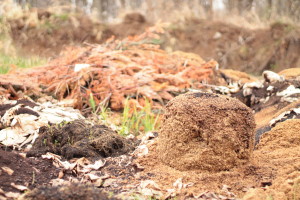 Perhaps it should have been more obvious that spent grains are a huge concern in the brew house. Brewing leaves an abundance of nutrients in the grains husks and residue. Many breweries channel their spent grains into raising live stock and eggs. Others provide them to bakeries and local sausage makers. Some work with composters who referment the spent grains to generate heat while creating high quality soil that he used in his landscaping business.
Perhaps it should have been more obvious that spent grains are a huge concern in the brew house. Brewing leaves an abundance of nutrients in the grains husks and residue. Many breweries channel their spent grains into raising live stock and eggs. Others provide them to bakeries and local sausage makers. Some work with composters who referment the spent grains to generate heat while creating high quality soil that he used in his landscaping business.
I met Russ Henry when he was picking up grains from Harriet Brewing Company and I was getting shots of the brewery as work on the tap room began. The story of Giving Tree Gardens, compost, and local brewing was part of the documentary because it shows how growth in beer making positively impacts other local businesses. I actively pursued this angle for quite a while. Even shot video for Hippity Hops Farm featuring George Shetka talking with Matt Hall from Lift Bridge about local hops production. Ultimately these stories were cut from the film but have found a home on line.
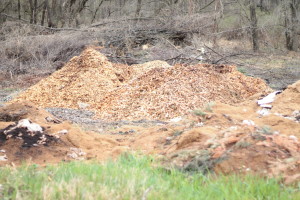 The way that Russ talked about making compost and soil had a major impact on the way I handled the editing process for Crafted to Last. I began to think in terms of spent video and refer to certain folders on the hard drive as video compost. Knowing that the video cut from the film would have another chance when I began to work through the compost piles at some later date made it a bit easier to make the first harsh cuts. The compost model ran deep. At one point Russ tells us about his “strategic piles” and how important they are to his process. I took this directly to heart and sorted the video compost at the source; strategically.
The way that Russ talked about making compost and soil had a major impact on the way I handled the editing process for Crafted to Last. I began to think in terms of spent video and refer to certain folders on the hard drive as video compost. Knowing that the video cut from the film would have another chance when I began to work through the compost piles at some later date made it a bit easier to make the first harsh cuts. The compost model ran deep. At one point Russ tells us about his “strategic piles” and how important they are to his process. I took this directly to heart and sorted the video compost at the source; strategically.
One of the more strategic piles is the video diary where I recorded my thoughts, inspirations and celebratory rituals as the film began to take shape. I’m mining that pile to support the CTL 2015 Film Tour. There are still many more clips steeping and fermenting in the video compost piles. We’re in for a long haul. Warm yourself as we decompose spent video. More refermentation is happening now.
CTL Film Tour 2015
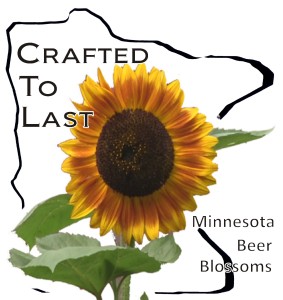 Shifting gears to get in tune with current events and future dates.
Shifting gears to get in tune with current events and future dates.
We’ve been planning the CTL Film Tour. It is becoming more likely that many of you will get a chance to see my home brewed film in your neighborhood this year. Already screenings are scheduled at Lift Bridge, Kinney Creek and Northgate on May 14, 15 and 16. In that order. Show times to follow.
In June we’ll be at Day Block and West Medicine Lake Community Club. June 3 we’ll experiment with the good people at Day Block on Pilot Batch Wednesday; 5-7 PM. On June 29th we’ll be in Plymouth; 7-9 PM.
Plans for bringing Crafted to Last – Minnesota Beer Blossoms back to Duluth are beginning to gel and friends in Denver, Chicago, and Portland are asking how we might be able to bring the film to their neighborhoods, too.
If you know someone or someplace that would like to host a showing during the 2015 film tour, get in touch with me. Brixton Hughes on FB or [email protected]. From June to November. We are willing collaborate with the breweries to create specialty beer and video for release at the screening event.
This short clip is offered to entice: More on the MN Craft Beer Project channel.
Its A Documentary
 Early on, my main purpose was simply to capture the initial phases of the social and economic impacts of reformed beer distribution laws in Minnesota. I was not yet certain what form the finished video would take, but I knew that the sooner we got the cameras running, the better. Production began in January 2012, by April of that year it had become clear that I was making a movie, and by June the working title was Crafted to Last.
Early on, my main purpose was simply to capture the initial phases of the social and economic impacts of reformed beer distribution laws in Minnesota. I was not yet certain what form the finished video would take, but I knew that the sooner we got the cameras running, the better. Production began in January 2012, by April of that year it had become clear that I was making a movie, and by June the working title was Crafted to Last.
I wanted the film to reflect the kinetic tension that was surging through the brewing community in the wake of the newly enacted Surly Pint Law. Everywhere I looked around the MN beer scene, something was being built, expanded or improved and everyone had quite a few opinions about all of it.
The ideas was to create a film that looked as though all I did was set up the cameras and turn them on. I thought that this approach would underscore the growth in the brewing sector because it implies that the blossoming of Minnesota brewing could be captured in real time; as if it were happening right before our eyes. Which is, in fact, precisely where and when this film happened.
The conversational setting for the audio narration track of the film imparted a similar sense because it let the people in the film narrate with their own words. Because the featured speakers are talking to each other the audio track could be fashioned as one extensive and winding conversation. It tells a lot of stories and weaves them into a larger scale narrative about what happened when beer distribution laws changed in 2012 and what it meant for Minnesota brewing.
The first conversation segment was shot in the tasting lounge at Harriet Brewing Company on March 30, 2012. Location shoots at Olvalde Farm (April 29), Leech Lake (May 19) and Brau Bros Brewery in Lucan (June 3) followed and the ball was rolling. My initial goal was to recruit 4-6 breweries to the project and include 2-3 local businesses that had benefited from the emergence of craft brewing in Minnesota. The conversation with Russ Henry from Giving Tree Gardens and Paul Johnston, then with Harriet Brewing had already been shot and edited. It was time to celebrate, so I cracked this bottle of 15.
That the video diary clip celebrates the 4th conversation segment is significant. Not only because I thought 4 breweries was enough to make a movie, but also because the entire film was designed around the numbers 3 and 4. Specifically in terms of the alchemical equation so often remembered as the Axiom of Maria. Carl Jung found this narrative structure, along with many others, in virtually every single text he analyzed. He looked at that result and made conclusions about human psychology. I looked at the result and understood something about narrative structures that attract human beings to the story being told.


